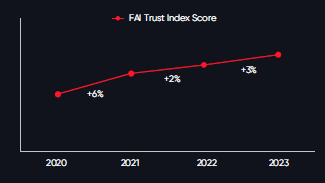Reading Time: 6 minutes
The IT industry, a cornerstone of India’s economy contributes 7.5% to the country’s GDP. According to the Great Place To Work’s research report, despite its economic importance and technological advancements in areas like AI and deep tech, the industry has experienced a 1% drop in overall employee perception. This decline is primarily attributed to decreased camaraderie (-1%) and reduced sense of employee pride (-1%).
Burnout levels remain a concern, affecting 26% of employees across the industry. These challenges underscore the need for a strategic focus on three key areas:
1. Employee Wellbeing: Addressing the rising burnout risk and overall employee experience.
2. Workplace Camaraderie: Rebuilding team spirit in the era of hybrid work.
3. Leadership Excellence: Investing in upskilling to meet the growing demand for a skilled workforce.
By prioritizing these areas, IT companies can navigate the evolving landscape and foster a more engaged, productive workforce.
The Need for Prioritizing Employee Wellbeing
The IT industry faces a significant challenge with burnout, affecting 26% of employees across the sector. This rate remains stable from 2022 but exhibits an 8% variability across different verticals. Notably, the ITES vertical maintains the highest burnout levels at 29%, while IT Consulting sustains the lowest at 21%.

Interestingly, burnout levels vary across roles and genders. Supervisory roles report 5% more burnout than senior managerial roles. Among senior managers, females experience a 5% higher burnout rate than their male counterparts.
However, there’s a silver lining. Best Workplaces in the IT industry have 5% fewer employees experiencing burnout compared to other workplaces. This difference highlights the impact of effective wellbeing strategies on employee experience.
Strategies for improving employee wellbeing
Recognizing the importance of employee wellbeing, 77% of IT companies now track this crucial aspect. Over half (55%) use multiple methods to monitor employee wellbeing, indicating a growing commitment to comprehensive approaches.
Effective wellbeing strategies encompass physical, mental, and emotional aspects:
- Physical Wellbeing: Initiatives may include fitness programs, ergonomic workspaces, and health check-ups.
- Mental Wellbeing: Companies are implementing stress management programs, mindfulness sessions, and access to mental health professionals.
- Emotional Wellbeing: Focus on creating a supportive work environment, fostering work-life balance, and providing employee assistance programs.
First American (India)’s Wellbeing Initiative
First American (India) (FAI) exemplifies a successful approach to employee wellbeing through their ‘Swasthya’ program. This holistic initiative offers support across emotional, physical, and financial dimensions:
- Wellness Corner App: Conducts health assessments and provides online consultations.
- Tranquil App: Aids in mindfulness and stress management.
- Hybrid Work Model: Ensures flexibility at work.
- Focus Group Discussions: Assess well-being, encourage feedback via anonymous surveys, and result in transparent action plans.
This multi-faceted approach has contributed to FAI’s recognition as one of India’s Best Workplaces™ in IT & IT-BPM for five consecutive years, demonstrating the positive impact of prioritizing employee wellbeing.

Fostering Workplace Camaraderie
The IT industry has experienced a 1% drop in the Camaraderie dimension, reflecting a concerning trend in workplace relationships and team cohesion. This decline is particularly significant as it contributes to the overall 1% decrease in employee perception across the industry.
The impact of this decline is far-reaching, affecting not only employee satisfaction but also productivity, innovation, and overall organizational performance.

Fostering Workplace Camaraderie
To address the camaraderie challenge, IT companies are implementing various strategies:
1. Cross-functional teams: 28% of IT companies have embraced cross-functional teams, fostering collaboration across departments and enhancing team spirit.
2. Remote work initiatives: With 76% of employees utilizing remote working options
3. Emphasis on communication: Implement clear communication channels and encourage open dialogue among team members.
Case study: Aristocrat’s Camaraderie Initiatives
Aristocrat, recognized as one of India’s Best Workplaces in IT & IT-BPM, has successfully fostered camaraderie through several innovative programs:
ShapeShifters Team: Drives engagement with creative online and offline programs for bonding, leadership connections, CSR activities, and honoring support staff.
Power Plays Platform: Encourages celebrating colleagues’ values-driven achievements, equipped with redeemable awards and e-cards.
Friday Box-Office Sessions: Led by subject specialists, these sessions promote discussions, self-growth, empathy, and team camaraderie through films on sensitive topics.
As a result of these initiatives, Aristocrat reports a 7% higher positive sentiment in the dimension of Camaraderie compared to the IT & IT-BPM industry average. Over 80% of employees have been recognized at least once through their peer-to-peer recognition platform, fostering morale, engagement, and positive workplace dynamics.
The growing demand for skilled workforce
The IT industry is experiencing a surge in demand for advanced digital skills, particularly in emerging technologies like AI, Data Science, Cloud Computing, and Cyber Security. This trend is driven by:
Rapid technological advancements: The industry’s shift towards advanced technologies like Quantum Computing, Blockchain, and AR/VR.
Global competition: India’s position as a hub for tech talent with global delivery capabilities.
Future projections: By 2028, India’s digital talent gap in the tech industry is expected to increase 2.8-fold, reaching around 28-29%, with demand exceeding 6 million professionals.
This growing demand underscores the critical need for continuous upskilling and leadership development in the IT sector.

Investing in training and development
Recognizing the importance of a skilled workforce, IT companies are making significant investments in training and development:
Widespread training opportunities: 82% of IT employees report receiving training and development opportunities, reflecting a strong industry-wide commitment to upskilling.
Substantial financial investment: The average annual investment by IT companies in training and development is ₹1.97Cr, demonstrating the sector’s dedication to nurturing talent.
Developmental Plans: 68% of IT Companies have development plans for all employees across levels.
LatentView Analytics’ S.T.E.P. Program
LatentView Analytics exemplifies leadership excellence through its S.T.E.P. (Stride Towards Excellence Program) initiative:
Objective: Cultivate future analytics leaders over a two-year comprehensive program.
Implementation
- Intensive training focusing on business leadership, analytics consulting, and thought leadership
- Candidate selection identifying potential leaders
- Leadership group mentorship involving experienced leaders
- Focus on personal and professional excellence
Impact
- Prepares a new generation of skilled analytics leaders
- Boosts understanding of business dynamics and strategic decision-making
- Enhances essential leadership skills for team and growth management
- Significantly contributes to LatentView’s growth and innovation in analytics
This case study demonstrates how targeted investment in leadership development can drive organizational success and foster a culture of continuous improvement and innovation.
The Interconnected Nature of These Focus Areas
Employee Wellbeing, Workplace Camaraderie, and Leadership Excellence are deeply interconnected, creating a powerful synergy that drives organizational success. When employees feel cared for, they are more likely to form strong relationships with colleagues, reducing burnout and fostering team cohesion.
This camaraderie, in turn, enhances Leadership Excellence by creating a supportive environment that nurtures emerging leaders and promotes better communication and mentoring. Skilled leaders further reinforce Employee Wellbeing by addressing concerns effectively and fostering trust and psychological safety.
These interconnections significantly impact key organizational metrics:
Employees experiencing personal fulfilment, a key aspect of wellbeing, are 1.7 times more likely to stay with their organization, and across verticals, this results in a 40% higher intent to stay.
Strong team dynamics, driven by camaraderie, lead to 1.6 times higher productivity, with a 36% higher perception of productivity levels.
Leadership Excellence is directly linked to innovation, with employees 3.5 times more likely to see innovation opportunities and a 45% higher perception of receiving these opportunities.

Together, these focus areas create a positive feedback loop, where improvements in one area catalyze enhancements in others, ultimately driving overall organizational performance.
These interconnected focus areas directly impact retention, productivity, and innovation. IT industry leaders must take decisive action to implement comprehensive strategies addressing these key areas, ensuring their organizations remain competitive and resilient in an ever-evolving landscape.
Get Certified to Showcase Your Commitment
Achieving Great Place To Work Certification is an excellent way to demonstrate your organization’s commitment to employees’ overall wellbeing and experience. This Certification not only enhances your employer branding but also helps attract and retain top talent. It highlights to current and prospective employees that your organization values their health, happiness, and overall wellbeing.
By implementing a culture of trust, respect, and collaboration, you can create a workplace where employees feel strong, healthy, and connected. Certification also provides a benchmark for continuous improvement, helping you identify areas where you can further enhance employee well-being and overall workplace culture.









